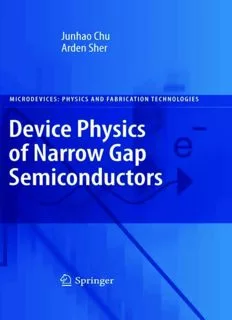
Device physics of narrow gap semiconductors PDF
Preview Device physics of narrow gap semiconductors
Microdevices: Physics and Fabrication Technologies SeriesEditors ArdenSher SRIInternational MenloPark,CA USA MarcyA.Berding AppliedOpticsLaboratory SRIInternational MenloPark,CA USA Forothertitlespublishedinthisseries,goto http://www.springer.com/series/6269 Junhao Chu (cid:129) Arden Sher Device Physics of Narrow Gap Semiconductors 123 JunhaoChu ArdenSher NationalLaboratoryforInfraredPhysics SRIInternational(Retired) ShanghaiInstituteofTechnicalPhysics,CAS 333RavenswoodAve. Shanghai200083,China MenloPark jhchu@mail.sitp.ac.cn CA94025-3493,USA arden-sher@comcast.net and LaboratoryofPolarMaterialsandDevices EastChinaNormalUniversity Shanghai200241 jhchu@sist.ecnu.edu.cn ISBN978-1-4419-1039-4 e-ISBN978-1-4419-1040-0 DOI10.1007/978-1-4419-1040-0 SpringerNewYorkDordrechtHeidelbergLondon LibraryofCongressControlNumber:2009932685 (cid:2)c SpringerScience+BusinessMedia,LLC2010 Allrightsreserved.Thisworkmaynotbetranslatedorcopiedinwholeorinpartwithoutthewritten permission of the publisher (Springer Science+Business Media, LLC, 233 Spring Street, New York, NY10013, USA),except forbrief excerpts inconnection with reviews orscholarly analysis. Usein connectionwithanyformofinformationstorageandretrieval,electronicadaptation,computersoftware, orbysimilarordissimilarmethodologynowknownorhereafterdevelopedisforbidden. Theuseinthispublicationoftradenames,trademarks,servicemarks,andsimilarterms,eveniftheyare notidentifiedassuch,isnottobetakenasanexpressionofopinionastowhetherornottheyaresubject toproprietaryrights. Printedonacid-freepaper SpringerispartofSpringerScience+BusinessMedia(www.springer.com) Foreword Thesubjectofsemiconductorscienceandtechnologygainedimportanceinthelatter halfofthetwentiethcenturywiththefirststagesstudiesofresearchongroupIVele- mentsandIII–Vgroupbinarycompoundsemiconductors.Muchoftheearlydevice workconcentratedonPbSnTealloys,butthismaterialhadseveralproblemsrelated toitshigh-dielectricconstant.TheIII–Vcompoundsemiconductorwiththenarrow- estgapwasInSb(energygapis0.18eVatroomtemperature)andwasnotsuitedto themid-waveorlong-waveinfraredranges.Tosatisfythedemandoftheinfraredde- tectiontechnology,anarrowgapsemiconductoralloyappearedin1959,theternary alloy Hg Cd Te based on HgTe and CdTe, from which narrower bandgaps can 1(cid:2)x x be reached. By changing the composition value of x, it was possible to meet the demands of infrared detectors in several important wave bands. Meanwhile, some interestingphysicalpropertiesappearedduetothenarrowerenergybandgap.Itim- mediatelyattractedintensiveresearchattention.Professionaldiscussionsrelatedto this material appeared around 1976. In 1976, an international conference named “Narrow Gap Semiconductors” was initiated. From then on, several other confer- encesrelatedto“II–VIGroupSemiconductors”or“NarrowGapSemiconductors” havebeenheld,forexample,theconferencessponsoredbyNATO.Thescaleofev- eryconferencewaslargesothattheirproceedingsformedthebasisofanimportant branchofsemiconductorscience.Duringthisrapiddevelopmentalprocess,several proceedingsandreviewpapersrelatedtothistypeofsemiconductorwerepublished. Tomyknowledge,thisbookisthefirstinternationaltreatisewhichfullyreviewsthe researchresultsofnarrowgapsemiconductors. One of the authors of this book, Professor Junhao Chu, has made many contri- butionstothefieldofnarrowgapsemiconductors.Heisconsideredoneofthemost suitable authors for a comprehensive book on narrow gap semiconductor physics. He was invited to update the database of Hg-based semiconductors for the new versions of “Landolt-Bornstein: Numerical Data and Functional Relationships in ScienceandTechnology”publishedin1999and2008. It has been my pleasure to read this book and the authors’ previous book (“Physics and Properties of Narrow Gap Semiconductors,” Springer 2008) in de- tail.TheyexploremanyresearchfieldsofHgCdTe,includingbasiccrystallographic propertiesandgrowthmethodsfromearlystudiestopresentresearch,principlesand measurementsofphysicalphenomena,andsoon.Therefore,thisbookisnotonlya v vi Foreword necessaryreferenceforthosewhoundertakeresearch,teaching,andindustrialwork onnarrowgapmaterials,butalsoofvalueforthoseundertakingworkrelatedtoall semiconductors. Prof.Ding-YuanTang MemberofChineseAcademyofSciences ShanghaiInstituteofTechnicalPhysics,CAS Preface Thephysicsofnarrowgapsemiconductorsisanimportantbranchofsemiconductor science.Researchintothisbranchfocusesonaspecificclassofsemiconductorma- terialswhichhavenarrowforbiddenbandgaps.Paststudiesonthisspecificclassof semiconductor materials have revealed not only general physical principles appli- cable to all semiconductors, but also those unique characteristics originating from the narrow band gaps, and therefore have significantly contributed to science and technology. Historically, developments of narrow gap semiconductor physics have been closely related to the development of the science and technology of infrared opticalelectronicsinwhichnarrowgapsemiconductorshaveplayedavitalrolein detectorsandemitters,andotherhighspeeddevices.Thisbookisdedicatedtothe study of narrow gap semiconductors and their applications. It is expected that the present volume will be valuable not only in the understanding of the fundamental scienceofthesematerialsbutalsothetechnologyofinfraredopticalelectronics. Therehavebeenseveralbookspublishedinthisfieldinrecentdecades.In1977,a Britishscientist,D.R.Lovett,published“SemimetalsandNarrow-BandGapSemi- conductors” (Pion Limited, London). Later, German scientists R. Dornhaus and G. Nimtz published a comprehensive review article in 1978, whose second edi- tion, “The Properties and Applications of the HgCdTe Alloy System, in Narrow GapSemiconductors,”wasreprintedbySpringerin1983(SpringerTractsinMod- ernPhysics,Vol.98,p.119).Thesetwodocumentsincludedsystematicdiscussions ofthephysicalpropertiesofnarrow-gapsemiconductorsandarestillimportantref- erences in the field. In 1980, the 18th volume of the series “Semiconductors and Semimetals” (edited by R.K.Willardson and Albert C. Beer) in which very use- ful reviews were collected, was dedicated to HgCdTe semiconductor alloys and devices. In 1991, a Chinese scientist, Prof. D. Y. Tang, published an important ar- ticle, “Infrared Detectors of Narrow Gap Semiconductors,” in the book “Research andProgressofSemiconductorDevices”(editedbyS.W.Wang,SciencePublish- ers,Beijing,p.1–107),inwhichthefundamentalprinciplesdrivingHgCdTe-based infrared radiation detector technology were comprehensively discussed. In addi- tion,ahandbook,“PropertiesofNarrowGapCadmium-basedCompounds”(edited by P. Capper), was published in the United Kingdom in 1994. This handbook vii viii Preface contains a number of research articles about the physical and chemical properties of HgCdTe narrow-gap semiconductors and presents various data and references aboutCd-basedsemiconductors. This book, “Device Physics of Narrow Gap Semiconductors,” is the second in atwo–volumesequenceonnarrowgapsemiconductors.Thefirstvolume,“Physics and Properties of Narrow Gap Semiconductors,” (Springer 2008), focuses mainly on materials physics and fundamental properties. Both volumes describe a variety of narrow gap semiconductor materials and revealing the intrinsic physical prin- ciples that govern their behavior. In this book, narrow gap semiconductors are presented within the larger framework of semiconductor physics. In particular, a unique property of this book is its extensive collection of results of research de- duced by Chinese scientists, including one of the authors of this book, although the results are integrated into the larger body of knowledge on narrow gap semi- conductormaterialsanddevices.Inorganizingthebook,specialattentionwaspaid tobridgingthegapbetweenbasicphysicalprinciplesandfrontierresearch.Thisis achievedthroughextensivediscussionsofvariousaspectsofthefrontiertheoretical and experimental scientific issues and by connecting them to device-related tech- nology.Itisexpectedthatbothstudentsandresearchersworkinginrelevantfields willbenefitfromthisbook. The effort was encouraged by Prof. D. Y. Tang. J. Chu is most grateful to Prof. D. Y. Tang’s critical reading of the manuscript and invaluable suggestions and comments. A. Sher is indebted to Prof. A-B Chen for invaluable suggestions. The authors are also grateful to numerous students and colleagues who over the yearshaveofferedvaluablesupportduringthewritingofthisbook.TheyareDrs: Y. Chang, K. Liu, Y. S. Gui, X. C. Zhang, J. Shao, L. Chu, Y. Cai, B. Li, Z. M. Huang, X. Lu¨, L. He, M. A. Berding, and S. Krishnamurthy. We are indebted to ProfessorM.W.Mu¨llerforhiscarefulreadingoftheEnglishmanuscriptofVol.I. TheelectronicfilesofthemanuscriptswereeditedbyDr.H.ShenandDr.X.Lu¨. TheresearchofJ.Chu’sgroupasispresentedinthisbookwassupportedbythe National Natural Science Foundation of China, the Ministry of Science and Tech- nologyofthePeople’sRepublicofChina,theChineseAcademyofScience,andthe ScienceandTechnologyCommissionoftheShanghaiMunicipality. March2009 JunhaoChu ArdenSher Contents 1 Introduction.................................................................... 1 2 ImpuritiesandDefects........................................................ 5 2.1 ConductivityandIonizationEnergiesofImpurities andNativePointDefects............................................. 5 2.1.1 Defects........................................................ 5 2.1.2 Chemical Analysis of Impurity Defects andtheirConductivityModifications ....................... 10 2.1.3 TheoreticalEstimationMethodforImpurityLevels ....... 14 2.1.4 DopingBehavior............................................. 27 2.1.5 ExperimentalMethods....................................... 34 2.2 ShallowImpurities ................................................... 46 2.2.1 Introduction................................................... 46 2.2.2 ShallowDonorImpurities ................................... 49 2.2.3 ShallowAcceptorImpurities ................................ 54 2.3 DeepLevels........................................................... 61 2.3.1 DeepLevelTransientSpectroscopyofHgCdTe............ 61 2.3.2 DeepLevelAdmittanceSpectroscopyofHgCdTe ......... 69 2.3.3 FrequencySweptConductanceSpectroscopy .............. 75 2.4 ResonantDefectStates............................................... 79 2.4.1 CapacitanceSpectroscopyofResonantDefectStates...... 80 2.4.2 TheoreticalModel............................................ 83 2.4.3 ResonantStatesofCationSubstitutionalImpurities ....... 85 2.5 PhotoluminescenceSpectroscopyofImpuritiesandDefects....... 87 2.5.1 Introduction................................................... 87 2.5.2 TheoreticalBackgroundforPhotoluminescence ........... 89 2.5.3 InfraredPLfromanSb-DopedHgCdTe....................103 2.5.4 InfraredPLinAs-dopedHgCdTeEpilayers................108 2.5.5 BehaviorofFeasanImpurityinHgCdTe..................113 References.......................................................................119 ix
Description: